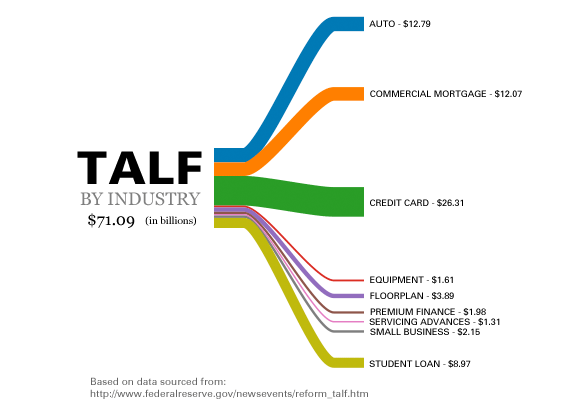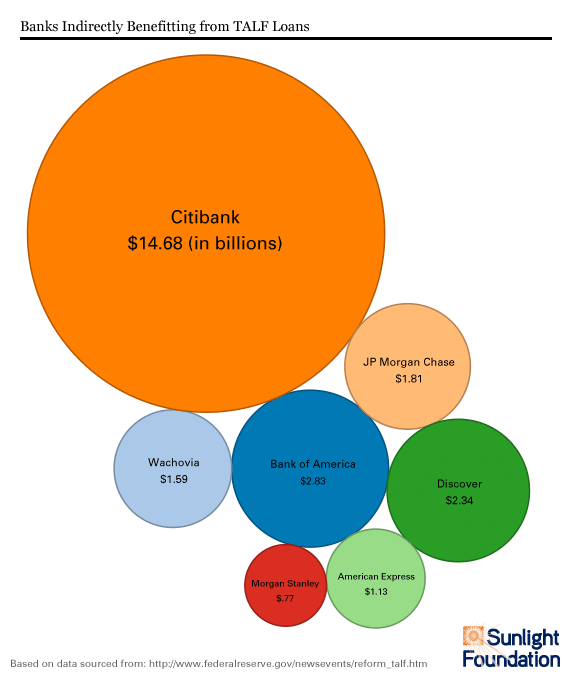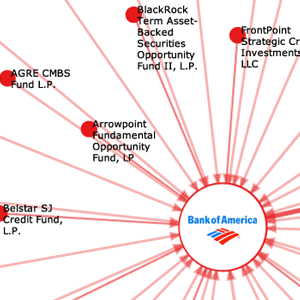Nation’s biggest banks benefit most from Fed program
Data recently disclosed by the Federal Reserve shows that one of its emergency lending programs, the Term Asset-Backed loan Facility or TALF, led to the purchasing of assets from 56 organizations–among them seven were also aided by the biggest bailout program, the Troubled Asset Relief Program, or TARP. Those seven financial firms benefited from $25 billion–or 35 percent–of the $71 billion in loans issued through through TALF.
More than two years after the financial crisis was touched off by the collapse of Lehman Brothers, when Congress, the Bush administration and independent agencies like the Federal Reserve took unprecedented actions to prop up bankers, brokers and other financial firms, the public is only now beginning to see detailed information on actions the government took that were considered secret before. While the Federal Reserve has released transaction level detail for TALF purchases, something that was ordered by Congress, it has withheld much of the underlying data for other emergency programs; Bloomberg.com reported that the Fed did not release information on the underlying securities purchased through the Term Securities Lending Facility program (TSLF) or the Term Auction Facility (TAF).
That program, launched in November 2008, issued $71 billion in loans to 177 investors. Those investors purchased assets from 56 companies and their subsidiaries*, including manufacturing giants like General Electric, auto industry firms including Chrysler, Ford, General Motors, Hyundai, Nissan and CarMax, and the seven institutions that received TARP funds.

Under TALF, an investment firm like PIMCO or BlackRock received a non-recourse loan—one that didn’t have to be paid back if the investment lost money—and used it to buy asset-back securities from companies in a variety of industries, such as credit card securities from Discover, auto loan securities from BMW, or commercial mortgage-backed securities from JP Morgan Chase. The program was designed to create a no-lose situation for sellers or buyers, but taxpayers could end up on the hook if any of the investments go south. And because $30 billion in TALF loans have yet to be repaid, that is still a possibility.
Citibank, one of the nation’s biggest banks and one of TARP’s largest recipients at more than $45 billion, received the most TALF funds via third party asset purchasers. Some $14 billion—or 21 percent—of all TALF loans made went towards purchasing assets from the financial conglomerate.

Citibank sold many types of asset-backed securities through the program, including student loans, auto loans and credit cards. The bank also sold mortgage-backed securities.
As we previously reported, Bank of America had the ability to benefit from TALF two ways. The financial holding company sold almost $2.8 billion in securities to investors using Fed money, while BlackRock—an investment firm it had a stake in through its acquisition of Merrill Lynch–was able to arrange purchases of assets worth more than $2.8 billion. BlackRock is even recorded as an investor in Bank of America’s assets, purchasing $166 million worth of assets.
All seven of the TARP recipients—Citigroup, Bank of America, J.P. Morgan Chase, American Express, Wachovia, Discover Financial Services, and Morgan Stanley–that benefited from TALF are also politically active as lobbyists regarding financial matters and donors to political campaigns.
TALF involves multiple players and money from two government agencies, and was intended to create liquidity into firms by freeing up the balance sheets of companies that lend to consumers so those companies could in turn do more lending. Many of the assets sold through the program were classified as subprime and legacy. Legacy was a term given to mortgage securities that were poorly performing and caused trouble for the banks that held them.The Fed made guaranteed, non-recourse loans to investors for assets such as these. The Department of Treasury gave the Fed a $20 billion insurance policy—taxpayer’s money—in case any of those investments went bad.
*We altered the Fed’s data release by combining parent companies with subsidiaries. For instance, we added all of Merrill Lynch’s assets and Banc of America Commercial Mortgage Trust assets to Bank of America. We also combined the Student Loan Corporation with Citibank, both subsidiaries of Citigroup.


